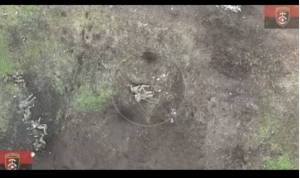It’s been four months since we talked about Ukraine, a period during which Russia put scores of thousands of poorly-equipped, pretty-much-untrained, and wholly incompetent civilian men into army uniforms (or facsimiles thereof) and fed them into the meat grinder that is Donetsk, Kherson, Bakhmut and surrounding areas.
With this result.

With things on the front lines pretty static, it’s time to think through the factors that will decide who wins. In layperson’s terms, I’d say there are three main drivers
People to do the fighting – today’s topic
Will to fight
Stuff to fight with
Yes, this is pretty basic, but stick with me here.
The “people” need to be found, trained, equipped, clothed, fed and led. These are all hard to do – especially in winter, in Ukraine, after 10 months of often-brutal combat dominated by death-by-artillery.
In addition to the usual recruiting efforts focused on patriotism and duty, Putin has resorted to two primary sources – poor men from far eastern Russia, many of whom don’t speak Russian, have never traveled outside their immediate area, are poorly educated and according to some reports not really interested in fighting.
Prisoners who, in exchange for a release from jail, agree to enter the army, often in mercenary units set up by the Wagner Group make up a large portion of the new recruits.
Reports from these new “soldiers” indicate they are mostly cannon fodder, placed on the front line to be killed by Ukrainian forces while the regular Russian army sites in relatively safe trenches in the rear.
This is typical (from Ukrayinska Pravda)
Quote from Agafonov: “We were dumped into the forest and ordered to entrench; we had only three shovels for the battalion, and there was no support at all. We entrenched as best we could, and in the morning the [Ukrainian] attack started. [Ukrainian forces used] artillery, Grad MLRS, mortars and copters; we were just shot.
What is disturbing is the lack of information about casualties and replacements in the Armed Forces of Ukraine (AFU). After way too much time spent searching the interwebs I was unable to find any credible data on recent losses, replacements, or changes in AFU manpower.
It’s highly likely that Russia has more men, even after both sides have suffered horrendous losses. (while there are women in both countries’ armed forces, men make up the vast majority of the fighting forces) It’s also clear that many new Ukrainian recruits are not exactly fully trained.
However, 5 weeks training by professional soldiers in Britain is a lot better than a few days with minimal training on how to actually shoot, load, and clean a rifle, bandage a wound, use a radio, read a map, and recognize a Russian or Ukrainian fighter jet.
Oh, and the UK and other European countries supporting the training give every trainee “combat clothing, body armour and ear defence, waterproofs and sleeping bags plus a fully stocked individual first aid kit and extreme cold weather kits…”
(for more on this I suggest you review multiple sources, as this will enable you to question each of them and arrive at your own conclusions… War on the Rocks, Phillips Payson O’Brien, Institute for the Study of War are three I’ve found useful)
Tomorrow – the will to fight.